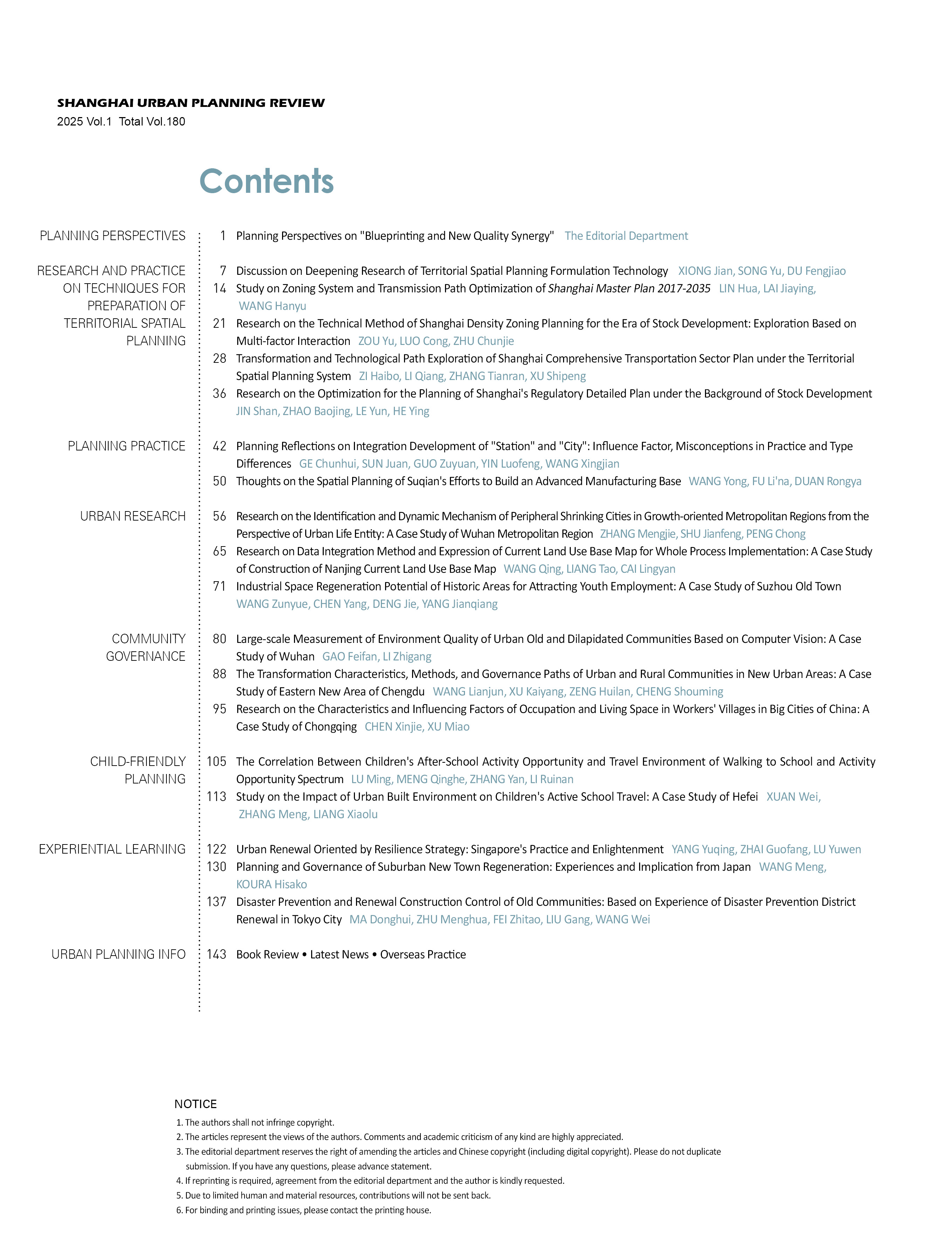
2025 Vol.1
Research and Practice on Techniques for Preparation of Territorial Spatial Planning

Discussion on Deepening Research of Territorial Spatial Planning Formulation Technology
Abstract: Planning formulation technology is a key step and an important foundation for the establishment of the territorial spatial planning system. Based on existing practices and research, this paper discusses critical issues in spatial planning formulation technology. First, the paper clarifies the conceptual connotation of spatial planning formulation technology, and analyzes the relationship between technology and methods, the technology of planning formulation and other specialized fields, and other aspects of planning technology. Second, it deepens the understanding related to the study of planning formulation technology, addressing the relationship between old issues of spatial planning from different departments in the past and new issues arising from territorial spatial planning reform, as well as the relationship between national and local practices. It emphasizes the need to strengthen the role of thinking mode in guiding planning formulation technology and proposes a shift in thinking mode across seven dimensions: space, system, implementation, stock, governance, design, and digitalization. Lastly, the paper discusses four key research directions for planning formulation technology: technical methods for element analysis; technical methods for spatial zoning identification, organization, and management; technical methods for planning implementation transmission; and technical methods for responding to digital transformation, aiming to provide a solid technical foundation for improving the capability of territorial spatial planning governance.
Study on Zoning System and Transmission Path Optimization of Shanghai Master Plan 2017-2035
Abstract: Zoning is a regional division that guides the differentiated allocation of various types of resources. It could be an important planning tool to meet the needs of diversified spatial governance, realize differentiated governance of various types of space, and ensure the effectiveness of the transmission of territorial spatial planning at all levels. In this context, the implementation path of achieving differentiated guidance and control based on zoning is widely explored. Shanghai Master Plan 2017-2035 (hereinafter referred to as "Shanghai 2035") has made innovative explorations in zoning, but there is still room for optimization and improvement in the zoning system and transmission path. Therefore, based on "Shanghai 2035", this article explores an open zoning system of basic zoning and overlay zoning. Basic zoning is mainly based on land use zoning, while overlay zoning is mainly based on form zoning and specific policy zoning, to achieve planning guidance for different zones. At the same time, combined with the existing legal planning system in Shanghai, this paper further researches and clarifies the content and methods of various planning zoning transmission.
Research on the Technical Method of Shanghai Density Zoning Planning for the Era of Stock Development: Exploration Based on Multi-factor Interaction
Abstract: Shanghai has researched the technical methods of density zoning planning earlier. The development density zoning control rules have been implemented for more than ten years and have played an important role in the planning and management of Shanghai. The Shanghai Master Plan (2017-2035) specifies the requirement of a decrease in planned construction land. While Shanghai has entered a new era that emphasizes the development of existing land uses, the main problem to be solved by density zoning has gradually shifted from formulating unified rules for incremental space development to improving the quality of urban space and promoting high-quality urban development. This article studies the optimization path of density zoning planning technical method in Shanghai. It proposes a framework based on the current situation and planning database, relying on a comprehensive transportation model, to combine the decomposition of the overall plan with dominant factors, in order to achieve the coordinated unity of intensity and height and the interactive feedback of "population - land – transportation - form". In addition, several rules for refined control will be further explored.
Transformation and Technological Path Exploration of Shanghai Comprehensive Transportation Sector Plan under the Territorial Spatial Planning System
Abstract: Comprehensive transportation planning, as an important sector plan in the national spatial system, is an important policy tool to guide spatial use, optimize spatial structure, and support spatial organization. With changes in population, industry, technology, and other factors, the pattern of national spatial protection and development is reshaping, and the demand for transportation systems has also undergone significant changes. This paper proposes the overall framework, element expression, and transmission requirements for the comprehensive transportation sector plan transformation under the Shanghai national spatial planning system. Based on the technical path of the comprehensive transportation sector plan, this paper explores the strengthening of the coordination between multimodal transportation and multi-scale space in development strategies, highlights the spatial control and refined management requirements of planning in element coordination, and promotes the transformation of comprehensive transportation planning from blueprint planning to leading planning for urban development process in implementation and transmission. This provides a forward-looking and structural planning perspective and approach for the comprehensive transportation planning of cities entering the stage of stock development, and provides guidance and references for the sustainable development of urban transportation.
Research on the Optimization for the Planning of Shanghai's Regulatory Detailed Plan under the Background of Stock Development
Abstract: How to transform the regulatory detailed planning under the background of stock development is not only an important part of Shanghai's further improvement of the territorial spatial planning system, but also a key focus for Shanghai to accelerate the practice of high-level urban renewal. Based on reviewing the practical process of regulatory detailed planning in Shanghai, this paper analyzes the new trends and challenges faced by regulatory detailed planning in the stage of stock development, explores the transformation direction of regulatory detailed planning, and proposes that regulatory detailed planning should be further optimized and improved in terms of increasing the flexibility of use control, optimizing the control of building layout, innovating planning techniques and methods, enriching the types of compilation organizations, and improving the forms of multi-party participation.
